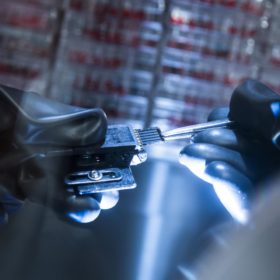
Scientists in Hong Kong have developed a cell they say retains more than 90% of its initial efficiency under accelerated testing conditions. The device is based on two-dimensional metal-organic frameworks.
Scientists from the City University of Hong Kong have developed a perovskite solar cell based on a 2D conjugated metal-organic framework which functions as an electron-extraction layer at the interface between perovskite and cathode.
The researchers claim their device is the first perovskite cell to offer good long-term stability and high power conversion efficiency at the same time and they state it also offers reduced lead leakage.
The City University group said metal-organic framework (MOF) materials have been used previously in perovskite research, but with the focus on using them to passivate defects in the perovskites themselves.
The Hong Kong group replaced three-dimensional metal-organic frameworks – which are susceptible to low charge-carrier mobility – with a two-dimensional structure equipped with thiol groups as a key functionality. Those groups consist of a sulfur atom with two lone pairs, bonded to hydrogen, with such structures used as interfacial modifiers to enhance the performance and stability of perovskite solar cells.
Commenting on the thiol groups, the City University team said: “They possess suitable energy levels, enabling them to be an electron-extraction layer where electrons are finally collected by the electrode of the perovskite solar cells. Our molecular-engineered MOFs possess the property of a multi-functional semiconductor and can be used to enhance the charge extraction efficiency.”
The City University solar cell showed efficiency of 22.02%, a fill factor of 81.28% and open-circuit voltage of 1.2 V. “Both the conversion efficiency and the open-circuit voltage recorded are among the highest values reported for the planar-inverted perovskite solar cells,” said the academics.
The device is also said to retain more than 90% of its initial efficiency under accelerated testing conditions at maximum power point tracking for 1,000h at 85 degrees Celsius.
The scientists said their cell also suffered less lead leakage than other perovskite devices. “Our experiments showed that the MOF used as the outer layer of the PVSC [perovskite solar cell] device captured over 80% of the leaked lead ions from the degraded perovskite and formed water-insoluble complexes which would not contaminate the soil,” said research co-author Alex Jen Kwan-yue.
Lắp đặt điện mặt trời Khải Minh Tech
https://ift.tt/2X7bF6x
0906633505
info.khaiminhtech@gmail.com
80/39 Trần Quang Diệu, Phường 14, Quận 3
Lắp đặt điện mặt trời Khải Minh Tech
https://ift.tt/2ZH4TRU
Không có nhận xét nào:
Đăng nhận xét